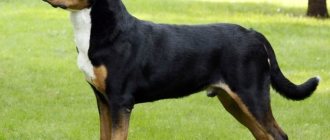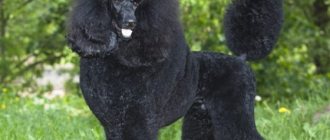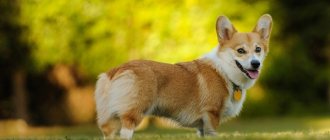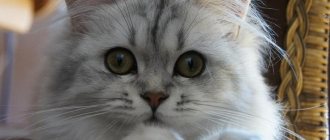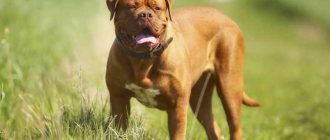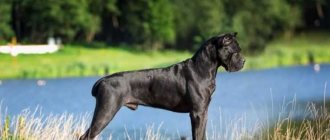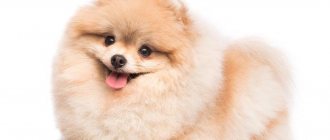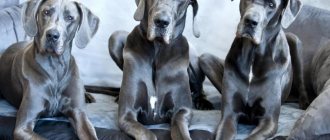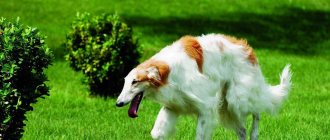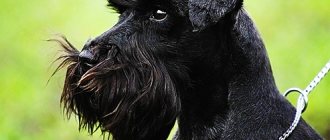Origin of the breed
The Great Dane is a descendant of Tibetan mastiffs. This opinion is shared by some breeders and owners of the breed. Another part supports the theory of Reiber, a famous German dog handler. Still others lean towards the eastern roots of the Great Dane dog breed.
Those who consider the Tibetan mastiff to be the ancestor of the Great Dane are right. Powerful and large dogs are widespread in the Near and Middle East, India, Nepal and Persia. Dogs were used as hunters and guards; the oldest depiction of a battle between a Tibetan mastiff and a lion has been preserved. But the dog's main vocation was war. Menacing and vicious, they inflicted severe injuries on their opponents.
As time passed, representatives of the breed accompanied numerous armies on the battlefields. Thanks to this, mastiffs came to Molossia (present-day Albania), and then to Greece. According to some sources, Alexander the Great became interested in the breed, but there is a version that he was a fan of Great Danes. Due to this, representatives of the breed have become widespread worldwide.
The Romans learned about powerful and vicious dogs. They began to buy representatives of the breed to participate in wars and battles. Ancient Rome is famous for its Colosseum; not only slaves and gladiators died in its arena, but also dogs. Such bloody entertainment continued for a long time; if the Roman army did not take part in military campaigns, the mastiffs entertained the most respectable public with battles.
During another conquest mission, the Romans encountered the Celts. They turned out to be the owners of muscular and powerful dogs that managed to give worthy resistance to the Roman mastiffs. According to one version, some of the mastiffs went to the Celtic army as trophies. They were crossed with their Great Danes, as a result of which a new dog was born, more flexible and muscular than its ancestors, characterized by increased aggression towards strangers and fellow dogs.
In the Middle Ages, the Great Dane breed became widespread in Europe. Only representatives of the nobility could afford to keep such a dog. For some time, representatives of the breed ceased to be used for military purposes. They went hunting with them or were used as guards. But with the discovery of the New World, animals again went on the “warpath”. The Spanish conquerors brought them to America; the Great Danes turned into cruel and merciless killers, because they were set against the Indians who inhabited the mainland.
The first description of Great Danes appeared in the 16th century. Five main types have been identified, and a variety of colors are noted. In those days, the exterior of Great Danes was somewhat different from that of modern dogs. Representatives of the breed were distinguished by a powerful chest and excessive growth, given the size of current dogs.
The breed's popularity took off in the 19th century. Great Danes lived in palaces and were kept by noble people. Dogs of that time were distinguished by their tall stature, harmonious physique and sophistication. In the 19th century, the standard of modern representatives of the breed was born, and special attention was paid to its purebredness. Depending on the area, their own types of dogs were formed - Welsh, Danish and others.
When the time came to write a breed standard, the Danes tried to adapt it to their dogs. But the animals described contradicted the general program for breeding Great Danes. German dog breeders rebelled against the Danish ones, and a serious struggle ensued. The Germans won, the Danes were left empty-handed, and soon their dog breed disappeared. Although the Great Dane is still mistakenly called Danish.
The current breed standard was written in 1879. Then, under the leadership of the director of the Berlin Zoo, and also a dog handler, a commission was assembled to adopt a single standard. In the same year, a book called “Great Dane” was published, in which the breed standard was published.
In Russia, its representatives appeared even before the revolution. They were supported by those close to the royal family. During the Great Patriotic War, Great Danes practically disappeared, but Moscow breeders and enthusiasts set about reviving the breed.
At the moment, Great Danes are less popular than in the Soviet Union. However, there is a demand for puppies, new nurseries are being created in Russia.
General characteristics of Great Danes as a breed
Great Danes are one of the largest dogs. Their height can reach 110 cm, and some representatives of the breed weigh more than 90 kg. But despite their enormous size, Great Danes are not evil. These are calm, intelligent and very loyal animals. They do not show aggression and are quite sociable. Although this is an excellent guard and watchman, when danger arises, it boldly rushes to protect the owner and his property.
The Great Dane is also popular because of its elegant, beautiful appearance. This is an aristocrat and even the Apollo of the dog world. For this reason, the breed is often called the Royal Dane.
The main characteristics of the Great Dane are independence, good nature, calmness, and intelligence. The breed can be used as a bodyguard, guard, watchman, in guard and escort service. But it is also a wonderful companion, devoted friend, nanny and protector for the child. These dogs are ideal for large families, respectful of people and easy to train.
The photo shows that Great Danes are huge but good-natured dogs:
Walking with a little girl
Huge Great Dane
Great Dane with a child
| Options | Characteristic |
| breed name | Great Dane, Royal Dane |
| country of origin | Germany |
| time of adoption of the first standard | 1880 |
| group of breeds according to the ICF classification | Molossians, mastiff subsection |
| height | males 80-90 cm, females 72-84 cm |
| weight | males 63-79 kg, females 50-63 kg |
| life expectancy | 8-10 years |
| usage | watchman, security guard, companion |
| character traits | calm, loyal, fearless, good-natured, intelligent, reliable, cheerful |
| aggressiveness | do not show aggression, get along well with other pets |
| activity | tall, needs long walks with running and outdoor games |
| intelligence | smart |
| training | uncomplicated |
| attitude towards people | friendly, loyal, love children, suspicious of strangers |
| need for communication | sociable, do not tolerate loneliness well |
| health | weak, live on average 5-7 years |
| care | easy, moderate shedding |
Pros of the breed
Great Danes are popular dogs for families with children and active young people. The breed is suitable even for inexperienced owners, as it is non-aggressive and easy to train. These pets have many advantages:
- balanced psyche;
- obedient, calm character;
- unobtrusive, intelligent behavior;
- impressive, beautiful appearance;
- rarely bark;
- devotion, sociability, good nature;
- high intelligence;
- no aggression towards strangers and other animals;
- are a good companion, ready to accompany the owner everywhere;
- can become a nanny and a reliable protector for a child;
- short hair, sheds lightly.
Cons of content
But these pets have serious disadvantages. Due to their height, Great Danes are difficult to keep in a city apartment. They are not suitable for very busy people, as they require a lot of attention and do not tolerate loneliness well. There are several other disadvantages of the content:
- requires a lot of space in the apartment for sleeping and playing;
- cannot be kept in an enclosure;
- Because of their short fur they get cold in winter;
- large weight and size can become a problem during active games, the dog can accidentally cause injury;
- high consumption of products;
- poor health, Great Danes rarely live longer than 8 years;
- high physical activity required;
- increased salivation.
The video complements the information about the pros and cons of Great Danes:
Video: Great Dane
Video: Great Dane pros and cons of the breed
Interesting Facts
This is a young breed that appeared in the 19th century, although such large dogs have served people since ancient times. A lot of interesting facts about Great Danes have accumulated.
- Great Danes are giant dogs. For their height they are included in the Guinness Book of Records. A Great Dane named Zeus had a height at the withers of 110 cm, and when he stood on his hind legs, the height of this giant reached 220 cm. And the dog George, with a height of 109 cm, weighed more than 100 kg.
- Sometimes you can find the name “Royal Great Dane”. The dogs are called this because of their enormous size, but they are the same breed.
- Many people know the breed thanks to the cartoon about Scooby-Doo - a funny and cowardly Great Dane. Although in fact real dogs do not look like this character.
- In ancient times, similar dogs were found in all countries. They took part in dog fights, helped people in war, and guarded property. In England they were used for hunting. But the breed is called German, since the first standard was developed in Germany.
- In Russia, the Great Dane appeared even before the revolution, but was not popular. During World War II, all dogs of this breed were destroyed.
- These dogs have the shortest life expectancy. Even in favorable conditions, they live on average 6.5-7 years.
Pictures from the Internet show what an interesting dog the Great Dane is:
Great Dane and Chihuahua
Three merle Great Danes
Got bored
Can drink water on his own
Great Dane and cat
Description of the breed with photos
The FCI places Great Danes in the second group. Working tests for representatives of the breed are not provided.• General appearance: large, harmoniously built dog with a noble disposition.
- The head is large, long, but not wedge-shaped. The length of the skull is half the length of the head. The transition from forehead to muzzle is well defined.
- The muzzle is deep and voluminous; a square format is considered ideal.
- The eyes are almond-shaped and medium in size. Both dark and lighter colors are allowed, depending on the color of the dog.
- The ears are set high and of medium size.
- The nose is large and well defined.
- The jaws are strong, wide and powerful. Scissor bite.
- The neck is muscular and strong.
- The body is long and muscular.
- The back is short, wide, smoothly blending into the lower back.
- The loin is somewhat convex and short.
- The croup is wide, with powerful muscles.
- The tail is set high and reaches the length of the hock joint. It is widened at the base and narrows towards the end.
- The forelimbs are strong, muscular, with tightly fitting shoulder blades.
- The hind limbs are strong, parallel to each other, with pronounced angles.
Size and weight
The minimum height for a male Great Dane is 80 centimeters . The maximum reaches 1 meter a.
Females are shorter, the minimum height is 72 centimeters, the maximum is 85 centimeters .
Males can weigh from 50 to 90 kg. , females - from 45 to 60 kg . The Marbled Great Dane is the tallest among the rest; its height at the withers can exceed 1 meter.
Color and coat type
The coat is short, dense, and adheres well to the skin. Basic colors allowed by the standard:
- Acceptable colors of a fawn dog range from sand to red-golden.
- Black with white markings on chest and paws. The standard allows for a coat color, when the dog has black covering its head and body, and the neck, chest, belly and limbs are painted white.
- The brindle mastiff has the most beautiful color. There are uniform black stripes against the background of the main color.
- Blue color, its shade is bluish-gray with a steel tint. The Blue Great Dane is the most popular among breed lovers.
- Marbled, where the main color of the Great Dane is white, with black spots scattered over it. Their color is allowed, but gray or brown is undesirable.
History of the breed
According to one version, the ancestors of the Great Dane, Asian fighting dogs , came to Europe along with the nomadic tribes of Asia. By crossing with local dogs, they gave rise to the formation of the breed. The second legend says that this giant appeared due to the crossing of an old English bulldog and hunting boar dogs.
Over time, the branches of breeders split and produced different types of dogs. One medium-sized type was intended for hunting predators such as bears and wolves. The second type - huge dogs with remarkable strength, were intended for protection. At the same time, the term “Great Dane” used to mean any large and strong dog.
The blood of greyhounds was later added to the second type of dog to make it lighter and more agile. This is how the dogs appeared, which in 1878 received the name “Great Dane”. The first standard and description of the breed appeared at a dog show in 1880, and 8 years later the first club of breed lovers was organized.
Over time, the exterior standard has changed and been supplemented. Germany has been and remains the main center for the development and improvement of Great Danes: the best breed lines are represented there.
Previously, representatives of the breed were used as service dogs, today they are companions and family friends.
Interesting fact: representatives of the Great Dane breed twice became the largest dogs in the world - they were Giant George and Zeus. These males reached a height of 110 cm and 111 cm, respectively. So far no one has outgrown them.
Health and illness
Representatives of the Great Dane dog breed suffer due to their high stature. Like many giant dogs, Great Danes are prone to problems with the musculoskeletal system, hip and elbow dysplasia, and cardiovascular diseases. Major diseases affecting dogs:
- Eye problems: glaucoma, cataracts.
- Osteosarcoma or bone cancer.
- Dermatitis.
- Gastric volvulus.
The most painful are blue dogs and harlequins (marbled dogs).
Lifespan
Great Danes rarely live past 10 years. Their average life expectancy is from 6 to 8 years .
Important! The pet needs regular examination by a veterinarian. A visit to a specialist once a quarter is mandatory.
Diseases and health problems
Despite their power and beauty, Great Danes have very poor health. They rarely cross the 9-year mark and at 8 years old they are already considered old people. Like all large breeds of dogs, they have a weak heart and are susceptible to various diseases of the joints and bones. Joint dysplasia, arthritis, osteochondrosis and bone cancer are the most common diagnoses. Problems with the thyroid gland occur quite often, and eye diseases, including cataracts, are common.
The main cause of death for many Great Danes is volvulus. This pathology can develop in a matter of hours and cannot be avoided without surgical intervention. You cannot hesitate, since death without surgery is inevitable. Volvulus develops even in a completely healthy, young animal. In this case, the dog experiences rapid bloating, vomiting and heavy breathing.
Interesting fact: I often suffer from skin diseases, dermatitis, and allergies. Parasites that can carry serious diseases are very dangerous. Pathologies of the hearing organs and deafness are common.
If you provide your pet with proper nutrition, taking into account its needs based on age, you can significantly improve the animal’s quality of life, delay the development of many pathologies, and prolong life. In addition to nutrition, you should provide your pet with a sufficient level of physical activity and quality care. It is necessary to carry out vaccinations and regularly visit the veterinary office not only if health problems arise, but also to receive advice.
Character and intelligence
The Great Dane is called the king of the dog world or Apollo among his own kind. The name fully corresponds to the characteristics of the Great Dane. Representatives of the breed are calm and self-possessed, have a sense of self-esteem and awareness of their superiority over other animals and people. Interestingly, the Great Dane understands perfectly well that a person is weaker than him, but does not take advantage of his own advantage.
In order for a dog to lose his temper, you need to really anger him. The Black Great Dane, like any other, gives the impression of being melancholic, but when a threat to the owner arises, the dog’s reaction is lightning fast. And where did the melancholy individual go? Instead, a formidable and powerful dog appears, ready to protect its owner to the last.
Representatives of the breed are highly trainable, but they require constant training. The dog needs early socialization, otherwise keeping it in the city will lead to tragic consequences.
History of Great Danes
The first dogs were hunters, like most ancient dogs. As man expanded his range of interests and acquired property, the specialization of these huge dogs also changed. The Great Danes both helped him and entertained him: they were shepherds, guards, warriors and even actors in bloody theaters - gladiators.
This dog can't help but attract attention.
How Great Danes became dogs for aristocrats
Most of us, speaking about Great Danes, imagine the image of the so-called royal breed, as they called the impressive-looking giants who were often seen on our streets back in Soviet times - “Royal Great Danes” were prestigious and popular.
Such a breed never existed, and the high-profile title was attributed to ordinary Great Danes not only for their regal bearing, but also for their eventful past. Their story begins in the palaces of Ancient Rome, where gigantic dogs spent time in noble idleness along with their patrician owners. According to some written evidence, dogs very similar to Great Danes were kept in the courts of the highest nobility of Ancient China.
Loyalty to the owner is the main family trait of every Great Dane.
Aristocratic appearance, selfless courage and exceptional devotion to the owner - the best qualities of Great Danes were appreciated in many countries of Medieval Europe. Gigantic dogs lived in castles and it seems they still remember it.
It is interesting that in Germany the ancestors of the modern Great Dane (the same royal one) were called very unusual and even pretentious - for example, “Dog in the superlative degree” or “Apollo among dogs.” These and some other original breeds were united in 1978 under the modest but sonorous name of the Great Dane.
For what purpose was the breed bred?
One should not assume that the outline of a giant, almost mystical dog adorned only the throne rooms of ancient castles - mastiffs were not bred for the sake of beauty. These are strong, diligent and hardy workers who did various jobs well:
- hunted wild boars, pumas and bears;
- shepherded herds and protected them from predators;
- protected the owner and his family from enemies;
- guarded the house and other household property.
Nowadays Great Danes all over the world are becoming primarily companion dogs, but they are ready at any moment to “turn on” the functions of a protector and a faithful guardian. Therefore, every such dog must be perfectly controllable - successfully complete a full course of training.
Education and training
As mentioned above, due to their nature, Great Danes require early socialization. You should start training them no earlier than 4 months of age; by this time the puppy must learn:
- respond to your name;
- walk calmly on a leash and wearing a muzzle, without trying to remove the latter;
- walk indifferently past cars, cyclists, strangers;
- do not try to chase street cats;
- know the prohibiting command and respond to it the first time;
- live according to the rules established in the master's house.
Great Dane training is approached in such a way that the pet becomes interested in learning. First of all, it is necessary to establish close contact between the animal and its owner. Without contact, good training will not work; a dog can work great on the playground, but ignore commands in everyday life.
All training is based on the principle of “simple to complex” and positive reinforcement. If correction of undesirable behavior is necessary, then conditions are created for the dog under which the desire to behave incorrectly disappears. All this is done without mechanical impact on the animal. Hitting a Great Dane is unacceptable.
Important! The sooner you start socializing your pet, the better for him and those around him.
Maintenance and care
Great Danes, due to their size, have difficulty living in small spaces. A representative of the breed is not suitable for a family living in a small apartment. The Great Dane is a big dog, it needs space; the ideal option for it would be its own home or a warm enclosure. In the latter case, there must be heating in the enclosure, because Great Danes are short-haired, and in winter they do not have the opportunity to warm up.
Dogs do not require special care. It is enough to comb them every week and occasionally wipe them with a damp towel. Bathing is problematic; many representatives of the breed have a negative attitude towards water. Two or three bath procedures per year are quite enough.
The pet's ears, eyes and teeth are examined daily. If discharge is detected from the eyes, wipe them with a damp swab. Contaminated ears are carefully cleaned, and you can seek help from a veterinary clinic. Brush your teeth once a week to avoid the formation of tartar on them. Nails are trimmed every three to four weeks.
Walks
The Great Dane needs movement. In its absence, dogs develop problems with the musculoskeletal system, and their hind limbs weaken. Walk adults twice a day, three times if possible. The time of one walk is 1.5-2 hours, at least.
Dietary recommendations
The Great Dane, like its brothers of other colors, loves to eat, but it should not be overfed. Balancing a dog's diet based on regular food is quite problematic. It is advisable to give preference to super-premium food designed for large and giant breeds.
If the owner prefers natural products, the list of permitted and prohibited products should be taken into account. A Great Dane is allowed to:
- lean meat - veal or beef, rabbit, turkey;
- vegetables without starch;
- rice cereal;
- low-fat cottage cheese;
- chicken or quail eggs.
- dog biscuits or dried bread as a treat.
- offal.
As can be seen from the list, the natural diet is quite meager. When feeding it, the dog should be given an additional complex of vitamins.
Important! Great Danes eat up to 3 kilograms of meat daily.
Care and maintenance of an adult dog
You can keep an English Great Dane both in a large mansion and in a city apartment. But subject to regular walking and physical activity.
In order for your pet to feel comfortable, it is necessary to follow some rules for the care and maintenance of such a large family member.
The right diet
Feeding an English Dane is not an easy task. The pet eats quite a lot. Therefore, most owners prefer to feed the English giant dry food.
You need to select exclusively premium food with calcium supplements to eliminate problems with bones and joints that are typical for dogs of powerful breeds.
When compiling a natural menu for an English Dog, it is important to comply with the following requirement: food should not be too high in calories.
A complete diet for a British Great Dane should include:
- varieties of dietary meat;
- eggs;
- low-fat fermented milk products;
- vegetables (exclude potatoes and cabbage);
- offal;
- sea fish fillet;
- porridge (rice, buckwheat).
You cannot feed English Danes food with spices, long bones, river fish, mushrooms, or food from the owner’s table. For an adult mastiff, 2 meals a day are enough. You should not overfeed, so as not to provoke obesity and unwanted complications.
Initially, you should choose the type of feeding: dry food or natural food. A combination of two types of diet is unacceptable. The digestion of a huge mastiff will certainly suffer.
The water in the English Dane's bowl should always be fresh, not boiled. Some owners use bottled products to avoid intestinal infections.
Walking and physical activity
The Great Dane has a homebody personality. However, you definitely need to walk your dog at least 2-3 hours a day, especially if the animal lives in an apartment.
A slow, calm Great Dane is sometimes difficult to engage in active play. But the owner should try, because physical activity is necessary for the health and proper development of the English Dane.
A light jog next to the owner or vigorous walking is quite possible for the British giant.
Important to consider! You should not walk your mastiff for a long time in hot weather. Due to the special brachycephalic structure of the muzzle, the breathing of the English Great Dane is somewhat difficult. In conditions of elevated temperatures, the animal begins to suffocate.
Training and education
Dogs of the English Great Dane breed, despite their calm, peaceful nature, need education and training. Once in a new home, the puppy must immediately understand that he is not the leader here at all.
It is necessary to stop the slightest attempts to display aggression and self-will. This should be done through suggestion, but not through physical punishment.
Affection and tenderness can conquer a stubborn pet. But the English Great Dane must respect the firm hand of the owner. Here you need to find a middle ground.
Training a mastiff is not difficult. The dog needs to be praised more often and its successes reinforced with treats. Then the English Great Dane will be happy to obey and obey. Screaming and hitting a mastiff is absolutely not suitable.
You should spend at least an hour training a grown-up Great Dane. It is necessary to repeat learned commands and add new ones. This needs to be done gradually.
Great Danes are highly intelligent. They quickly begin to understand what is required of them. However, some examples of English Great Danes, sensing weakness, can subsequently manipulate the owner and refuse to carry out certain commands, or begin to behave pitifully.
Not wanting to work, they try to “persuade” the owner to return home as soon as possible. You should not follow the lead of a four-legged lazy person. If the owner is unable to cope with the Great Dane on his own, he should seek advice from professional dog handlers.
Care and hygiene
Thanks to your pet's short coat, caring for him is not particularly difficult. The English Great Dane needs to be brushed once every 2 weeks. During shedding, use a stiff brush with bristles. To make the coat shiny and look healthier, you can use suede or fabric. Then the dog will become even more sleek, smooth and neat.
It is necessary to bathe a Great Dane no more than 3-4 times a year. Use only zoo shampoo during bath procedures. “Human” products can cause allergies, irritation and even excessive hair loss.
It is important! After bathing, you should not allow your English Dane to lie in a draft. Despite its indestructible appearance, the dog catches colds easily.
For English Great Danes there are mandatory hygiene measures:
- Dirt, sweat, fat, and food debris can collect in the folds on a dog's face. Therefore, every day you need to wipe the animal’s face with a soft cloth to prevent infection.
- The pet's ears are cleaned once a week with damp swabs, using a solution of boric acid for a drying effect.
- Eyes should be wiped with chamomile infusion or tea. If there is discharge around the eyes, a visit to the veterinarian is needed.
- Weekly dental brushing is essential to keep your pet healthy. This is done with a special brush or a bandage wrapped around the finger in several layers.
- The claws are periodically shortened with a special pruner for large breeds.
Following simple rules will preserve the health of everyone’s family pet and save the owner from unnecessary expenses at the veterinary clinic.
How to choose a puppy
We strongly recommend buying a puppy only from trusted nurseries. The fact is that breeding the breed causes certain difficulties; bitches often have problems bearing offspring. Babies are expensive; there is hardly a good puppy on the free classifieds board at the lowest price. Pay careful attention to the color of the animal; if a Great Dane is offered in brown, white or dirty gray, they want to sell the cross to a naive buyer for decent money.
When choosing a baby, pay attention to its appearance. A healthy puppy has the following characteristics:
- Fatness.
- Good bones and muscles.
- A pronounced transition from the forehead to the muzzle, as indicated in the breed standard.
- No scratching on the ears and body. The ears are clean.
- Skin pigmentation matches the baby's color. There are no red spots, allergic rashes or damage on it.
- The mucous membranes of the mouth are clean, there is no unpleasant odor from the mouth.
- The eyes are shiny, without any extraneous discharge.
- The area around the anus is clean.
- Particular attention should be paid to eye color. In blue dogs, they can be light or different. If a buyer is offered a black, fawn, brindle puppy with blue eyes, this is a reason to think about the integrity of the breeder.
A self-confident child, with a stable psyche and a royal character, behaves accordingly. He makes contact with pleasure, sniffing the potential owner, wagging his tail, and inviting him to play. When choosing a baby, we recommend doing several exercises that reveal his temperament.
- Carefully place the puppy on its back, turn it belly up and hold it in this position. If the baby is actively struggling, grumbling displeasedly, squirming and trying to reach the hand holding him, you should refrain from purchasing such a dog. He will grow into a leader dog; it is quite difficult to manage one without the appropriate skills. Does the baby tuck his tail between his legs, freeze, afraid to move and look at the person in horror? This is a future coward; there is practically no sense in such a four-legged creature. And if the puppy lies calmly on its back, wagging its tail and offering minimal resistance, it’s worth choosing him.
- Take the puppy in your arms, holding it by the stomach, and hold it in weight. A good dog calmly reacts to what is happening, looking around. The coward will immediately clamp down, and the dominant puppy will try with all his might to get rid of the invader.
- Throw a bunch of keys near the playing puppies. The baby’s interest, his calm approach to the subject and sniffing indicate the animal’s stable psyche. An overly active baby will begin to bark at an unfamiliar object and attack it. A cowardly puppy will prefer to retreat to a safer corner.
The Great Dane is an active, confident dog. A representative of the breed is suitable for wealthy people, since its maintenance requires significant costs. The dog will be an ideal companion for an active married couple with adult children, a representative man or woman who has time to raise a pet and walk with it.
Video about the breed
join the discussion
Share with your friends
The Great Dane is a large and quite strong dog. But this is not a separate breed of animals, but a whole group that includes several breeds of domestic dogs belonging to the Molosser group.
The success of living together is in education
In the modern world, the Royal Dane (also known as the Great Dane) dog has acquired all the qualities necessary for its current survival, but has not lost those thanks to which it gained its historical position.
The main thing about this breed is the ability to get along with almost any normal person. But! If you want to be not a service person, but at least an equal participant in the relationship, be able to prove it to the dog. Let's start with the fact that the Great Dane is a proud animal, so you should beat and scold him only in cases where he is really guilty. Otherwise, the dog may consider you an unfair (read: abnormal) owner and will continue to ignore you as incompetent. A reproachful tone and trust will be more effective, even when the puppy is naughty. At the same time, remember: if you give in and the dog doesn’t recognize you, you won’t get a comfortable existence, there will be a constant quiet war for supremacy.
Breeds
To date, 7 Great Dane breeds have been officially registered. Let's look at each of them in more detail.
German
Inexperienced dog breeders, as well as people who have nothing to do with the animal world, often call Great Danes simply Great Danes, implying that this is the only breed of animal that is included in the “Great Dane” category. In fact, this statement is incorrect. The thing is that animals belonging to this species are the most common, but far from the only ones.
This variety was born in 1971 in the territory of modern Germany. These animals have a proportional build, have long and thin limbs, and are also quite tall. Thus, the average height of a Great Dane at the withers is about 90 centimeters. The hair of animals is quite short and smooth to the touch. The color can be varied: black, white and even blue. By their nature and behavior, dogs are quite friendly and active. They are good at connecting with people.
French (the second name is Bordeaux)
The French variety is radically different from the German one in appearance. This type of domestic dog has a large nose, folds in the front part of the head, and drooping ears. The physique is quite large (as is typical for Great Danes), and the paws are massive. The Dogue de Bordeaux's coat can be various shades of brown and red. The coat itself is short and smooth.
The French Dogue variety does not like to be alone. Animals constantly need company, otherwise they feel stress, melancholy, sadness and other negative emotions. It should also be borne in mind that dogs belonging to this variety are leaders by nature, so they prefer to dominate other animals neighboring them.
In the process of keeping an animal, it is important to pay attention to training and education.
Argentinian
This variety was bred in the city of Cordoba. Its original purpose is to hunt large animals. With the development and spread of animal breeds, they began to be involved in other tasks: search and rescue work, as well as service in law enforcement and military agencies. Interestingly, Dogo Argentinos were also used as fighting dogs. As a result, the reputation of these animals was damaged.
Animals belonging to this species have highly expressed intellectual and mental abilities. If you take the process of training an animal seriously, you can raise a reliable guard and protector.
Tibetan
The Tibetan Great Dane is a dog breed that is shrouded in a mysterious and enigmatic history. There is no consensus not only about the origin, but also about the development and current state of the breed. Thus, a number of scientists believe that today there are no Tibetan Great Danes in their original form - the animals have been transformed into Tibetan mastiffs.
In general, Great Danes of the Tibetan variety have a fairly large body and very thick hair. As for the mental characteristics of animals, it is important to note their well-developed mental abilities and courage.
Brazilian
There are also Brazilian dogs. This type of dog differs from its counterparts in its strongly expressed protective instinct - four-legged pets will do their best to protect not only their owner, but also the territory in which they live. Since ancient times, Great Danes of the Brazilian breed have been used as assistants during hunting, as well as for herding livestock and chasing escaped slaves.
In the process of keeping an animal, great attention should be paid not only to upbringing and training, but also to socialization. If training takes place in the correct mode, you will get a loyal and kind four-legged friend.
Canary
It is believed that the original breed, which became a kind of progenitor of the Dogo Canario, is the Spanish fighting dog, which existed in the 3rd century BC. The Dogo Canario originated naturally; breeding scientists did not take part in its breeding. That is why the animal is of great interest to the canine society.
Canary dogs were used for a variety of purposes: as companions during the hunt, as guards, defenders, etc. The dogs' character is characterized by such traits as stubbornness and independence. Physically, Great Danes are quite strong and powerful.
English
Due to the fact that the animals often took part in military campaigns, English Great Danes are also called royal dogs. One of the most important features of these dogs is the ability to easily and quickly get along with people and find contact with them. However, such qualities are not completely natural; training is required to develop them.
Different breeds of Great Danes (despite the fact that they belong to one large category) have different physiological and mental traits, and the dogs also look different in appearance. On the other hand, animals are united by such universal characteristics as strength, power and large dimensions.
Historical reference
Where does the history of the origin of the breed begin? This issue is controversial from time to time, causing serious unrest in the canine world. The thing is that experts cannot come to a common opinion about the first ancestors of mastiff dogs. Great Danes are descendants of Molossians - there is no doubt about that, but scientists argue about the place of origin of Molossians.
There are two main versions:
- All Molossians are descendants of the ancient Tibetan Great Danes, huge, strong, rather determined and aggressive dogs. The population of these giants originated in eastern Europe, more precisely, on the Tibetan peaks. Evidence of the existence of Tibetan Danes has been found everywhere... from Syria to Persia and Nepal. Naturally, most often, the face of giants appeared during excavations in the Middle East. The oldest evidence of Tibetan Great Danes dates back to the 7th century BC, which suggests that Molossians are the ancestors of all canines.
- Great Danes are descendants of ancient Germanic dogs. This version, oddly enough, comes from German scientists. We are talking about the 5th century BC, more precisely, the period of the birth of the ancient Germanic tribes. However, if we take the hypothesis apart, the conclusion suggests itself that German dog handlers want to see “their truth” and finally appropriate the Great Danes to their country.
It is easy to guess that the first version is more fundamental and justified, and therefore is accepted all over the world. Cave paintings are obvious evidence of the similarity of dogs, but in science, verbal descriptions or discovered remains are more valuable. Descriptions of Molossians can be found in the chronicles of the ancient Persians, who valued the life of giant dogs more than human ones. In India, Molossians performed both service and religious roles. Anubis, the God who escorted people to the other world, is described as a man with the head of a jackal, but a number of scientists are inclined to believe that the deity personified a merciless Molossian.
This is interesting! Great Danes were named Molossians after their spread to Epirus. Giant quadrupeds were actively bred and used for hunting by Molossian tribes. In fact, thanks to dogs, tribes were known throughout eastern Europe.
In ancient China, quadrupeds also played an important role. Small dogs were the property of the nobility, but Great Danes were used for specific purposes. The point is that huge rice plantations were considered sacred lands, and hunting was prohibited on them. There was a nuance - hunting was prohibited for humans; the law was silent about hunting with the help of dogs.
Great Danes changed their “professional activities” with the development of the world, this is quite predictable. Despite their hunting and guarding qualities, the Molossians left their most significant mark in the history of wars. It has been scientifically confirmed that dogs, clad in armor, marched against Egypt in the same ranks as the Persian infantry. Molossians also played the role of soldiers in the Greco-Persian War; four-legged animals also fought on the side of Persia. As you know, the self-confident Persians lost the long-term confrontation and Greece entered the dawn period.
From developing Greece, the Molossians came to Rome. The stormy dawn of the breed began in the empire. The warlike Romans highly valued the power and aggression of dogs. Quadrupeds were used in military campaigns, and in peacetime, tailed animals entertained the public by fighting in arenas. Bloody entertainment gave the "gladiators" an enviable reputation, as cruel as it may sound, this brutal period gave the Great Danes a ticket to the future.
This is interesting! Alexander the Great played a significant role in the widespread spread of the ancient Danes. The king and commander not only revered four-legged fighters, but also led a competent “marketing strategy.” Only male dogs were transferred into the wrong hands and only for a lot of money. Over time, this technique led to increased demand and popularity of the breed line.
One of the last significant military events in the history of the Great Danes was the battle between the Celts and the Romans. Despite the fact that the empire used its Molossians, the Celtic Danes provided a worthy meeting for the troops. The battlefield was flooded with rivers of blood, as the Celtic dogs turned out to be worthy warriors, and outnumbered the enemy.
With the development of the world community, the invention of weapons and technology, dogs ceased to be used in battles and Molossians moved into the hunting class. Naturally, not everyone was able to feed a giant, so if a tailed ward was acquired, then the maximum was squeezed out of his skills. Wherever Great Danes were used, dogs hunted large animals, transported carts with cargo, protected protected areas and farms, participated in demonstrative baiting, guarded slaves, and even served as a means of execution.
Features of maintenance and care
A Great Dane dog needs a lot of space - this is due to both the large size of the animal and its natural activity and energy. In this regard, if you live in a small-sized city apartment, then you should refuse to buy such a large dog .
The Great Dane needs a separate equipped place, which should have bowls for food and water, as well as a bed (it can be purchased at a zoological store or made independently from improvised materials).
In order to meet the animal's needs, it is important to provide it with constant physical activity (at least long walks). Play outdoor games with your dogs and conduct constant training in the fresh air.
Great Danes require extra attention regarding hygiene. The thing is that these animals are not clean, so it is important to constantly monitor them. The most characteristic feature of Great Danes in this regard is constant and profuse salivation. In this regard, it is important to monitor the condition of the dog’s oral cavity and brush its teeth. In addition, it is important to regularly examine the animal’s ears and eyes. If necessary, they can be cleaned with cotton pads and sticks dipped in water. Don't forget to trim your nails regularly, too.
Water procedures are another important part of keeping Great Danes. Bathe dogs as needed in warm water and using special detergents. For convenience, you can use a hose or shower.
Dog food can be either natural or artificial. In the first case, it is assumed that the pet owner independently composes his diet, making sure that it is saturated with a large amount of vitamins and minerals and is balanced in terms of proteins, fats and carbohydrates. Do not feed your pet stale, poor quality food or table scraps. If you prefer feeding dry or wet ready-made formulas, then carefully ensure that they correspond to the breed of your pet, its age and physiological characteristics. Choose holistic and super-premium class food, do not buy cheap formulations - they can harm your pet’s body.
Character and habits of Great Danes
The German giant is a very loyal and sociable pet. His proud posture, graceful gait and intelligence are visible from afar. He never gives voice without a reason, is not fussy and calm. All Great Danes adore children and get along with other pets.
This powerful animal senses the slightest change in the mood of its owner and thanks to this it learns very easily. A dog understands a person perfectly, but for more effective training it must be interested.
Adult Great Danes are imposing and calm, while puppies love active games and can destroy everything around them in a short time. Only by the age of one year do puppies become more sedate. The Great Dane is not just a guard. Thanks to the expressed instinct of the guardian of weak members of his family, the dog can become a real nanny for his household, especially for children.
Interesting fact: Great Danes endure separation from their owner very hard. They get bored and may even get sick. It is vital for them to be close to their human family, to feel part of it.
The external calm of the Great Dane, his indifference to everything that happens around him, can be misleading. He closely monitors the situation and is always ready to protect his owner and other household members. It’s just that he never rushes into a fight, and does not succumb to the provocations of other animals. Unmotivated aggression towards strangers is excluded if the dog was initially raised in the right environment and the animal’s psyche is not impaired. In case of real danger, he acts with lightning speed and, basically, without warning by barking.
Education and training
Education and training are especially important for Great Danes. The fact is that these are very stubborn and independent animals that may not accept the authority of the owner if the animal is not trained. If possible, entrust the training procedure to a professional dog handler. During the training process, you should not use force or express aggression - the animal is very sensitive. However, at the same time, the Great Dane must be kept strictly so that he understands who is the boss here.
Training should begin from the very first days after you brought the puppy into your home. First, familiarize your dog with the basic commands (“stand”, “sit”, “voice”, etc.) and only then proceed to more complex tasks.
See below for more details.
The Royal Dane is the king among dogs, a huge dog that was mentioned in one of the works of Arthur Conan Doyle, and it was this dog that starred in the latest (domestic) film adaptation of the novel “The Master and Margarita”; it was the Royal Dane that lay next to Pontius Pilate, according to the version the director, of course. The most interesting thing is that conversations about the Royal Dane have not subsided for several centuries, when dogs of the Great Dane breed were popular in our area, and this was in the 90s of the last century, you could often hear the phrase Royal Dane on the streets. Many dog breeders simply do not know that there are many Great Danes in the world, but the Royal Dane does not exist at all.
These are the things, all these conversations were conducted around two breeds of dogs, the Great Dane and the Great Dane, these breeds were often confused with each other and were sometimes mistakenly called the Royal Dane. However, at the end of the 19th century, these breeds were combined into one and became known as the Great Dane. So, if you hear the name Royal Dane somewhere, then you should know that there is no such breed.
Where did the legend about the Royal Dane dog come from? Everything is very simple, if you look at the photo of the Royal Dane (for convenience, this is what we will call the Great Dane in this article), then indeed in the features of this dog you will be able to notice something aristocratic, royal. A proud profile, huge size, proud posture, all this indicates that the dog is very noble. In addition to appearance, it is also misleading that dogs of this breed have always been close to European monarchs in the past. Indeed, if you go to one of the art museums, you can find many paintings depicting powerful people of the past: kings, queens, cardinals, counts, and very often in the paintings next to these powerful people in the past there are Great Danes, which later and began to be called royal.
Russia also did not lag behind Europe, and royal mastiffs were frequent residents of the houses of noble persons in the past. Thanks to this, people have developed a stereotype that a person walking next to such a dog must be very rich. So, as we have already said, the Royal Dane is a mistaken name for the Great Dane, but even now you can very often hear this name for the dog. Everything is very simple, and now dogs of this breed are quite popular in our area.
How much does a Great Dane cost?
The strict show standards of Great Danes make many puppies from a litter a "breeding failure." This does not in any way affect the dog’s life in a loving family, because we are talking about the nuances of color, set of ears and tail, paw arch and similar details. The cost of such pets is on average $300. If the price is significantly lower, it is highly likely that we are not talking about a purebred animal.
Promising Great Danes, which can make a career and be used for breeding, are much more expensive. If you have ambitious plans for purchasing a dog, be prepared to pay at least $1,000 for a puppy.
A few words about appearance
So, what are they - royal mastiffs? And they come in a variety of colors: black and white, white and black, brindle, black, sand. A dog can come in a variety of colors, but all these dogs have one thing in common - huge size.
Indeed, dogs of the Royal Dane breed can reach a height of up to 90-95 centimeters at the withers, can you imagine such a colossus?! The weight of a dog can exceed 60 kilograms and in general the dog’s appearance shows that I am very calm, but it’s better not to approach me and my owner with bad intentions, you will be safe, gentlemen bandits, and this is really so.
Character of the Royal Dane
Royal Danes really have a very calm and easy-going character. These dogs easily find a common language with all the inhabitants of the house. They get along easily with children, find a common language with other animals in the house, and treat strangers or unfamiliar people with suspicion, but they will not show aggression unnecessarily.
With proper training, you will get a very smart, loyal and devoted dog from the Royal Dane. These dogs are very happy to be close to their owner, they will always support your proposal to go for a walk or go out of town. In general, dogs of this breed have an excellent character and will not let you down at a crucial moment.
Pros and cons of Great Danes
The Great Dane is the largest dog, and for many lovers of this breed this becomes the main obstacle to getting one. These animals will not be comfortable in a small apartment, since they need a lot of space to relax and most likely they will have to give up the whole sofa and half the room.
Other disadvantages of the breed:
- Great Danes are not famous for their good health, and their lifespan rarely exceeds 7-8 years;
- These animals cannot stay outside for a long time in cold weather, since their fur does not have an undercoat;
- For full development and maintenance of health, the Great Dane requires careful care and special nutrition, but it is not cheap;
- Dogs of this breed do not tolerate loneliness well, therefore, if the owner often goes on business trips, then he should get another pet.
Let us now move on to the poles of the German giants:
- These are very reliable and friendly animals that become attached not only to the owner, but also to all family members;
- Great Danes are highly trainable, and even inexperienced breeders can handle them;
- Germans very rarely bark; they try not to disturb their household, even if they are in a cramped apartment;
- These dogs make excellent nannies and guards for children;
- Great Danes do not react to provocations of other dogs when meeting him during walks, and do not show aggression towards strangers.
You should not be led by momentary emotions and immediately get such a beautiful, but not simple dog. If you don’t create the right conditions for her, she will suffer and start getting sick. It is necessary to carefully analyze all the pros and cons of the breed, your capabilities, including financial ones, and only then make a decision.
